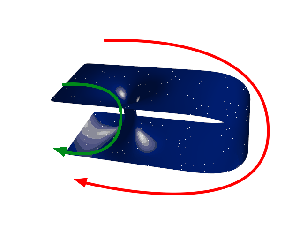FTL: Difference between revisions
More actions
→Notes: So contradicted I don't know why that's even noted |
→Introduction: grammar, case |
||
| Line 1: | Line 1: | ||
==Introduction== | ==Introduction== | ||
Acronym for <u>F</u>aster-<u>t</u>han-<u>L</u>ight. This is a term used to describe a means of astral propulsion utilized by the [[Cylons (RDM)|Cylons]] and the [[The Twelve Colonies (RDM)|Colonials]]. The standard term for FTL travel is | Acronym for <u>F</u>aster-<u>t</u>han-<u>L</u>ight. This is a term used to describe a means of astral propulsion utilized by the [[Cylons (RDM)|Cylons]] and the [[The Twelve Colonies (RDM)|Colonials]]. The standard term for FTL travel is '''"jump."''' | ||
The FTL drive makes interstellar travel possible for both the Colonials and [[Cylons (RDM)|Cylons]]. No longer confined to their own home solar system, the Cylons managed to avoid Colonial interference for 40 years after the [[Cylon War]] and establish their own homeworld. However, not all ships -- from small to large -- are outfitted with these drives ([[Miniseries]]). It's likely that FTL drives are not commonplace on many civilian ships because of the costs involved in using and maintaining the drive and the amount of [[tyllium|fuel]] available. For some civilian ships that travel comparatively short distances between some destinations, such as the ill-fated [[Botanical Cruiser]], FTL may simply be impractical or unnecessary. | The FTL drive makes interstellar travel possible for both the Colonials and [[Cylons (RDM)|Cylons]]. No longer confined to their own home solar system, the Cylons managed to avoid Colonial interference for 40 years after the [[Cylon War]] and establish their own homeworld. However, not all ships -- from small to large -- are outfitted with these drives ([[Miniseries]]). It's likely that FTL drives are not commonplace on many civilian ships because of the costs involved in using and maintaining the drive and the amount of [[tyllium|fuel]] available. For some civilian ships that travel comparatively short distances between some destinations, such as the ill-fated [[Botanical Cruiser]], FTL may simply be impractical or unnecessary. | ||
Revision as of 20:13, 20 April 2006
Introduction
Acronym for Faster-than-Light. This is a term used to describe a means of astral propulsion utilized by the Cylons and the Colonials. The standard term for FTL travel is "jump."
The FTL drive makes interstellar travel possible for both the Colonials and Cylons. No longer confined to their own home solar system, the Cylons managed to avoid Colonial interference for 40 years after the Cylon War and establish their own homeworld. However, not all ships -- from small to large -- are outfitted with these drives (Miniseries). It's likely that FTL drives are not commonplace on many civilian ships because of the costs involved in using and maintaining the drive and the amount of fuel available. For some civilian ships that travel comparatively short distances between some destinations, such as the ill-fated Botanical Cruiser, FTL may simply be impractical or unnecessary.
The technology behind FTL systems is such that, providing the relevant data is known, ships can jump with a high degree of accuracy, allowing ships to rendezvous in space and even "park" in a synchronous orbit directly above a given point on a planet's surface (Miniseries). Proper FTL use even enables vessels to arrive in crowded areas, such as the middle of an asteroid field or other ships, without the risk of collision and damage (The Hand of God).
No specific information on the technology of an FTL drive has been given in the Miniseries or regular series. We know only that Galactica has two FTL drives, and that other smaller or civilian ships have a single drive. We also know from dialogue that the FTL drives on Galactica are "spun up", suggesting a use of electromagnetic or centrifugal energies that may serve in creating the fields or forces needed to activate the engines.
Colonial Limitations
- Colonial FTL systems are not small-scale, and cannot be installed into vehicles such as the Viper. They can, however, be used on vehicles the size of a Raptor, which is limited to brief, short-distance jumps. Raptors can make a sequence of short FTL "hops" in a row, to reach the same destination as a capital ship with a full-sized FTL drive (Miniseries).
- Colonial FTL systems cannot be used multiple times over a long period of time, for they are prone to breakdown after excessive, repetitive use (33).
- FTL jumps can apparently induce nausea or discomfort in some people, such as Cally (Miniseries, Kobol's Last Gleaming, Part I)
- The wormholes generated by Colonial drive systems are limited in size; this defines the maximum size to which a colonial vessel can be built (hence the need for battlestars to retract their landing pods and reduce their overall cross-section prior to a jump (Miniseries, 33, etc.).
- Colonial FTL systems appear to be a holdover from the Exodus from Kobol, and their current designs have been developed to meet the needs of jumping between the Twelve Colonies, as their outposts in other star systems. Colonial FTL capabilities have defined limits, referred to as the Red Line, beyond which jumps may not be possible / could result in damage to a vessel's drive system / lead to navigational inaccuracies that might put the ship at risk.
- Navigators must be careful to plan FTL jump paths so as not to get too close to planets or other large objects, as they can be dangerous (Kobol's Last Gleaming, Part I).
Cylon Advantage
- Cylon FTL systems can be manufactured on a smaller scale to their Colonial equivalent, thus allowing the Cylon Raider to be outfitted with an FTL drive. (Miniseries).
- Cylon FTL drive systems are far more efficient than their Colonial equivalent. Tests with the Raider captured by the Battlestar Galactica (You Can't Go Home Again) demonstrated that the drive could enable the Raider to jump directly from the vicinity of Kobol back to Caprica (Kobol's Last Gleaming, Part I) - a jump completed by Lieutenant Kara Thrace during her search for the Arrow of Apollo (Kobol's Last Gleaming, Part II).
- The extreme ranges over which Cylon vessels can jump would indicate that Cylon navigation systems are far better integrated with their FTL system to enable such long-distance jumps to be accurately plotted.
- Given that the Cylons left Colonial space to find their own planet, it is possible that their longer-range FTL capability was created in response to a desire to be able to cover the distance between their adoptive homeworld and those of the Twelve Colonies with a single jump.
Background to FTL in New BSG
In establishing the series the creators of the new Battlestar Galactica determined to keep everything within the show very "natural". This means steering away from the standard clichés of television science-fiction: no bumpy-head aliens, no remarkable technology such as matter/anti-matter conversion, etc. So how is the concept of faster-than-light travel possible within this precept?
Underpinning Theories

The FTL drive technology used within the new Battlestar Galactica appears to be based on the use of Superstring Theory and M-Theory that essentially enable the "jump drive" systems to "fold" space, reducing the distance between any two points by creating a "corridor" through space that links them together (essentially forming a wormhole, or Einstein-Rosen Bridge). Such "corridors" are allowed by the general theory of relativity; what M-Theory does is provide a way to change the topology of spacetime dynamically.
The use of such Wormholes is based on the tenet that space is curved. Hence the term "wormhole", which arises from the analogy that space can be seen as an apple. A worm can travel from one side of the apple to the other in two ways:
- By crawling over the surface, or
- By burrowing through the apple (creating a "wormhole").
Obviously, the second option is considerably shorter than the first.
Relativistic Acceleration
A key point concerning the use of wormholes within the new Battlestar Galactica, is that they do not break the fundamental limiting factor of our universe: the speed of light. Vessels in the new Battlestar Galactica series do not accelerate to faster-than-light velocities. Rather, they use the wormhole to reduce the distance to their destination, thus giving the impression of faster-than-light travel.
This is the reason why FTL jumps are virtually instantaneous within episodes (e.g.33). It also means that the only direct form of propulsion available for vessels is generated by their sublight drive systems. In turn, this is why vessels exiting from a jump are seen to be travelling at the same velocity as when they committed to the jump (Miniseries, 33, The Hand of God, etc.)
Feasibility
While the use of wormholes in this manner is not currently possible, work is progressing on superstring and M-Theory which may make the creation of wormholes possible in the future. The limiting factor is the ability to generate negative energy densities, which are allowed (though severely restricted) by quantum mechanics. As such, the use of such systems again meets one of the stated desires of the the producers of the new Battlestar Galactica: not to rely on the "traditional" trappings of science-fiction that require exotic science and technology. Theoretical physicist Kip Thorne has carried out extensive research into wormholes, and helped develop a scientifically-consistent means of wormhole travel used by Carl Sagan in his novel "Contact" which bears a remarkable similarity to the technology employed within Battlestar Galactica.
Notes
- In the Miniseries, Colonel Tigh gives the impression that an FTL jump hasn't taken place in some 20 years and would be inadvisable. Given the preponderance of ships with FTL drives (some 63 comprising the suriving Colonial fleet alone (33). Tigh was probably referring to the last time Galactica herself made an FTL jump.
